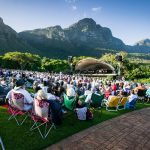Maybe it was impetuous of me to hand that money over to the young woman in Soweto. Possibly it was imprudent to slip on the harness and ride the caged industrial elevator to the top of that mural-covered utility tower turned bungee venue. Certainly it was unsettling to stand on the ledge, wind whistling in my ears and the township sprawling 90 metres below.
“Five!” chanted the young men behind me.
“Four! Three! Two! …”
But there’s no thrill without risk, right? This is what I told myself, and this must be what the high pooh-bahs of soccer were thinking when they brushed aside worries about crime, public health and infrastructure and decided to stage the FIFA World Cup in South Africa from June 11 to July 11.
Lots of people will be taking leaps of faith around here in the days ahead.
So I’ve just auditioned 10 adventures and excursions in and around Cape Town, Johannesburg and Pretoria — animal encounters, coastal walks, big-city explorations and the one flying leap, all within easy range of a World Cup venue. I stroked a cheetah, groomed an elephant, tasted crocodile (nothing like chicken) and checked out four stadiums. How often in life does a traveller behold the beautiful game and the Beautiful Game, furry cheek by stubbled jowl?
I did most of my exploring in the company of a guide or a group or local friends, and instead of walking anywhere at night, I took taxis. I did feel the gaze and heard the whispers of panhandlers and hustlers (in Cape Town’s Greenmarket Square, for instance). And a few statistics lingered in my memory: The World Health Organization estimates South African life expectancies at 50 years for men, 53 for women. The CIA estimates 18 per cent of South African adults are infected with HIV. Although most visitors to South Africa have no problems, the U.S. State Department says, “criminal activity, often violent, is prevalent throughout the country.”
Fortunately, being here is much more pleasant than reading the stats about being here. In fancy restaurants and in a squatters’ camp, I got genial welcomes.
More than 300,000 international visitors are expected during the competition’s 64 matches in 10 stadiums in nine cities. Surely, all will hear the call of the vuvuzela (a plastic horn, beloved by local crowds, that sounds like a trumpeting elephant) and all can hope for a glimpse of shibobo (when an attacking player dribbles the ball between the legs of a defender).
Here are the adventures, including what happened on that ledge in Soweto.
Cape Town
The Table Mountain Aerial Cableway is bound to be near the top of your Cape Town to-do list. The views are spellbinding (the mountaintop is about 1,055 metres above the sea), and the cost is a doable 160 rand (about $21 US) for an adult round-trip ticket. But you might never get up here.
The cableway closes in rainy or windy conditions — 50 to 80 days a year, management says — and in the South African winter months of June and
July, clouds often obscure the view. On my rainy three-day visit last month, the service never opened.
Instead of setting aside a specific day for Table Mountain, leave your itinerary loose enough for day-swapping. That way, if you wake up to a clear morning, you can head straight to the Lower Cable Station, about 15 minutes’ drive from the city centre. The cableway ride itself takes about five minutes. For weather updates and more info: 21-424-8181, www.tablemountain.net.
Near Cape Town: Cape Point
Cape Point isn’t the southernmost tip of Africa (it’s the southwesternmost), but because of its dramatic shape, it’s where you sense the continent running out. Clouds rippled across the sky at breakneck speeds; a wind-raked, roiling sea churned with the overlapping tensions of the Atlantic and Indian oceans. Oh, and the baboons. They roam free, know no fear and will grab food and open your car doors and scramble in if you don’t lock up.
From the Cape Point parking area, walk or take a shuttle bus to the 1860 Cape Point Lighthouse on the high ground. Then, if you’re not acrophobic, ditch the crowds by taking the Light House Keepers Trail.
The trail ends at Dias Point, a far finger of land that features another lighthouse (from 1910) and drop-dead views up and down the coast. On the way back to Cape Town, take Chapman’s Peak Drive, a 9-kilometre, 114-bend coast road built
by convicts from 1915 to 1922, that rivals California’s Highway 1 through Big Sur.
Near Cape Town: On the water
Even if it’s only for 45 minutes, you need a spell on the water. My plan was to take a boat out from Gansbaai about two hours’ drive east of Cape Town, climb into a cage and hope to see sharks up close near Dyer Island, a.k.a. Shark Alley. But as is common in winter, a storm scrubbed that excursion.
So I settled for a quick zip on a tourist boat around Hout Bay (about 45 rand, about $6). There were seals on rocks out there, but the real appeal was Sentinel Rock, looming in the mist, and the boiling, foamy waves. It’s easy to picture all the ships that have wrecked around here.
Easier still, you could take a Robben Island excursion (about three hours) or dinner cruise from Cape Town’s Victoria & Alfred Waterfront, a glitzy gathering of restaurants and shops just a couple of blocks from the new 70,000-seat Cape Town Stadium at Green Point (which will host eight World Cup matches).
Near Cape Town: The Cape Winelands
Winemaking in the Cape area dates to the 17th century, when Dutch settlers and French Huguenots began planting here. Now scores of wineries thrive around the cities of Stellenbosch, Paarl and Franschoek. Although the serious wine person will debate which tasting rooms deserve visits, let me offer these words to the not-so-serious: Go to Stellenbosch (about 50 kilometres outside Cape Town) and check out the palatial tasting rooms, cellar and grounds of erstwhile golfer Ernie Els built in 2004.
Then, for less grandeur and more action, head to the nearby Spier winery a vast enterprise where the tasting room is joined by a 155-room hotel, several restaurants, swimming pools, spa, craft market, horse stables, amphitheatre, eagle-rehabilitation centre and a cheetah outreach project where you can see fast cats up close and, for a few dollars more, pet one.
In Johannesburg: Law, disorder and rugby
Just about the worst move you could make in Johannesburg, many locals say, would be to linger after dark in crime-ridden Hillbrow, the neighbourhood next to Ellis Park Stadium. But if you have tickets for one of the matches at the stadium (perhaps the June 18 contest between the U.S. and Slovenia), remember: This is where, in 1995, South Africa’s then-President Nelson Mandela (now 91 and retired from public life) donned a green athletic shirt and walked on to the field to show solidarity with the nation’s mostly white national rugby team as it faced a World Cup final match. This is the moment the movie Invictus was built around, and white South Africans still marvel at the power of that moment.
In Johannesburg: Soweto
For the World Cup faithful, the centre of the universe is Johannesburg’s dramatically upgraded Soccer City Stadium, site of the tournament’s first match (South Africa versus Mexico on June 11) and its final one on July 11.
But if you’re curious about South African society, another vital stop is just a few miles away: Soweto. Born in the early 20th century as a residence for black male labourers, the township received global attention in the 1970s and ’80s as a site of profound poverty and key battles in the campaign against apartheid. Now it’s a big chunk of Johannesburg with two malls, a major hospital and an estimated two million or more residents, some in spacious residences, others in squatters’ shacks. Sign on for a day-long tour and you’ll see Vilakazi Street, where Mandela lived in the 1940s and ’50s and where Archbishop Emeritus Desmond Tutu lives now.
In the Motsoaledi Informal Settlement (a. k.a. squatters’ camp), where about 20,000 people live in shacks and unemployment is estimated at 60 per cent, resident tour guide Mandla Shongwe explained, “People are using paraffin for cooking, so there are a lot of fires, especially in winter.” Still, Shongwe said: “There is a difference between living in poverty and living in misery.”
In Johannesburg: The Apartheid Museum
Make time for this. South Africa’s history is a tangled, bloody, inspiring, irony-and-surprise-ridden story, especially the apartheid years from the late 1940s to the early 1990s. This provocative museum ( www.apartheidmuseum.org),opened in 2001, is the place to take it in. Allow two or three hours, even if you don’t usually linger in museums.
Near Johannesburg: Critters up close
Some of the best wildlife game-viewing in South Africa is at Kruger National Park, but for travellers who want to grab game encounters closer to Johannesburg, Pilanesburg Game Reserve (www. pilanesberg-game-reserve. co. za) is an easier choice, about 90 minutes from Johannesburg or Pretoria, next door to the Sun City casino and entertainment complex. Or, if you need to stick within an hour of Johannesburg but still want to reach out and touch an elephant, there’s the Elephant Sanctuary at Hartbeespoort Dam.
Near Johannesburg: Pretoria
If you keep travelling north 50 kilometres, you’ll hit Pretoria. This leafy city is the seat of South Africa’s executive government, home to the stolid old buildings around Church Square, and the century-old Loftus Versfeld Stadium, which will host six World Cup matches, including U.S.-Algeria on June 23.
After downtown Joburg and Soweto, Pretoria feels like a different country, its history dominated by Afrikaner farmers (aka Boers), mostly descended from Dutch, German and French immigrants, who came to South Africa centuries ago. These are the white farmers who fought the British for control of the country in the 19th and early 20th centuries, the dogged fighters whose leaders instituted apartheid in the 1940s.
Near Johannesburg: The high-up lowdown
For an easy bird’s-eye view of downtown Joburg, try the 50th-floor observation deck of the Carlton building, which rises above a mall. Or you could do what I did. We were in Soweto, driving by the Orlando Towers, a pair of concrete cooling towers (picture Three Mile Island) that helped deliver electricity to the city from the 1950s until 1998. Since then, the towers have been covered top to bottom by colourful murals. And since 2008, the towers have been rigged with gear for bungee jumping and something called “power swinging,” which is like rappelling (so you go down feet first, not head-first). The tower spoke to me.
Soon I was stepping into the orange shipping containers that serve as the operation’s offices, watching a couple of other jumpers, inquiring about prices (360 rand, about $48, for a power swing, 60 rand, about $8, for a ride to the viewing platform) fatalities (none so far) and traffic (40 jumpers on a busy Saturday). Then I was up top, trying to keep cool.
“Look,” I wanted to say. “I can see Desmond Tutu’s house from here.” But what came out was:
“Um. Feeling some nerves.”
“Perfectly natural,” said the jump master. Then came the countdown. And then I took the big step and plunged in free-fall for a purported 3.5 seconds (it felt like less). As tension on the ropes increased, my fall slowed and I swung back and forth, those enormous murals growing and shrinking and coming and going at crazy angles, the sound system throbbing below. Eventually the Earth came up to gently greet me. It was a hoot. I hope the World Cup works out the same way.
source: vancouver sun





